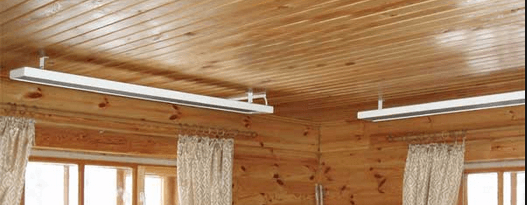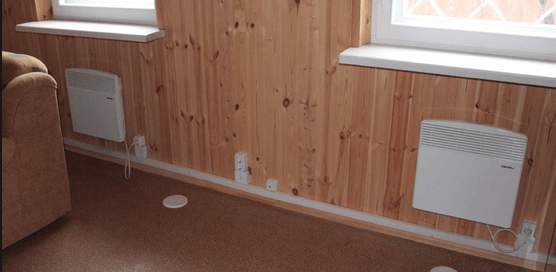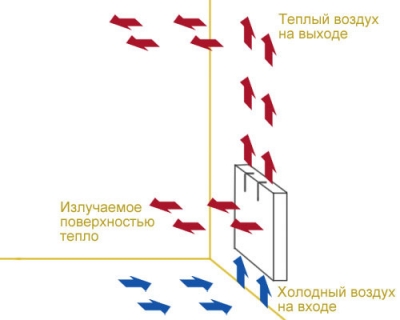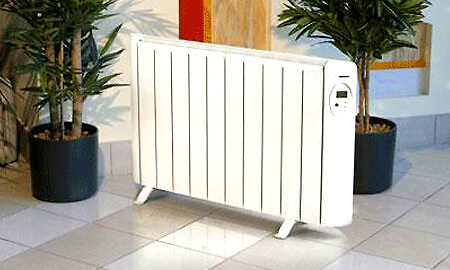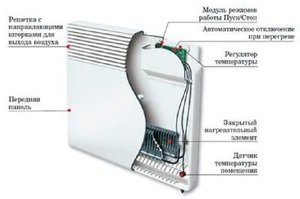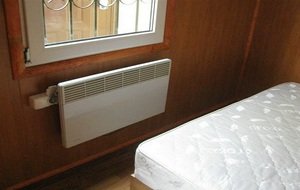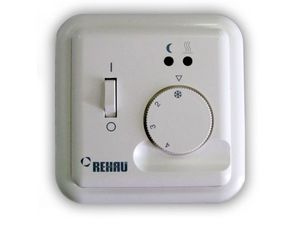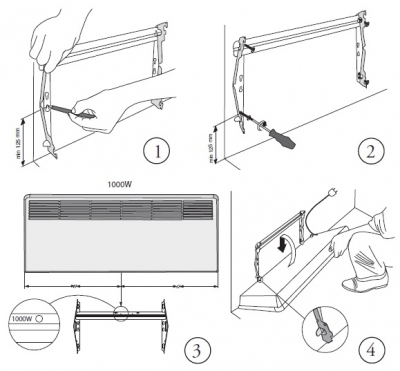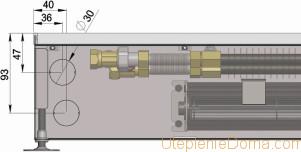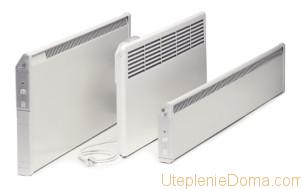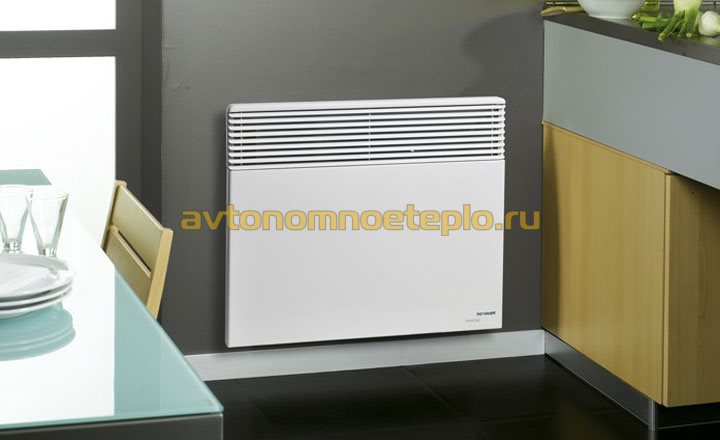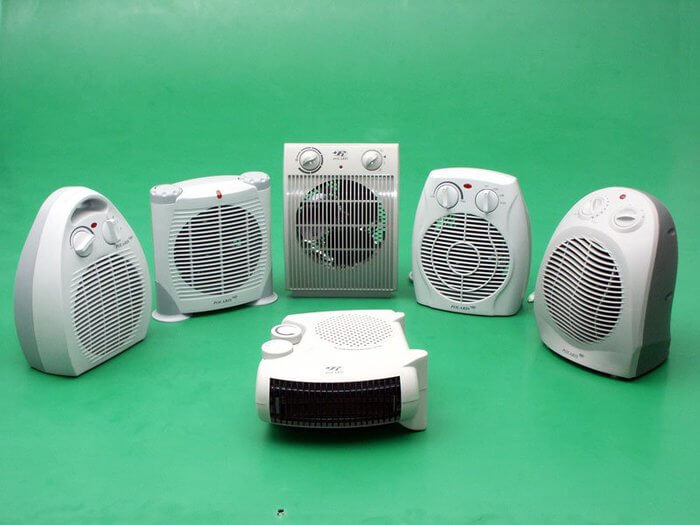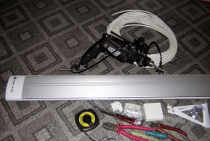Heating system options
So, consider the existing equipment that will make electric heating in the house economical and cheap.
Boiler use
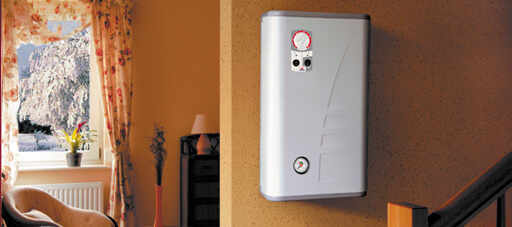
Using IR panels
Installing infrared heaters is the smarter solution and likely the most cost effective. The fact is that these products do not heat the air in the room, but certain objects (floor, walls, closet), from which heat is transferred in the future. If in the previous version hot air rises to the ceiling and immediately cools down, then in this case the heat is directed to the floor, which is more reasonable (people do not walk on the ceiling).
This diagram shows the effectiveness of an economical heating system for a private house:
You see everything for yourself, so there is nothing more to prove. It should only be noted that IR devices can work more efficiently if you add thermostats to them. One controller is enough to control three heaters in the economical heating system of a private house. We talked about how to connect a thermostat to an infrared heater in a separate article.
Using convectors
Many manufacturers convince that the electric convector effectively heats the room and at the same time spends a small amount of electricity. Of course, the question is debatable, because, in fact, the principle of operation of products is similar to the version with radiators (the air rises). The advantage of convectors is that their installation and connection is not difficult. In addition, the heating of the heating element is about one minute, which is undoubtedly faster than in the case of water radiators.
Among the other advantages of electric convectors are:
- low cost (from 2 to 10 thousand rubles);
- fire safety (which is especially important when installing heating in a wooden house);
- you can gradually increase the heating system (one convector for a room is not enough, buy another one and connect it to the network without any problems);
- attractive appearance;
- trouble-free operation during power surges (also relevant in the private sector);
- compact dimensions.
Separately, I would like to recommend that you explore such a heating option as an electric underfloor heating. You can find out about this heating system by watching the video:
The use of warm floors
We analyzed the reviews of buyers who used this option and saw that the majority of people are satisfied with the purchase. The main thing is to additionally install a temperature controller to make economical electric heating in the house with your own hands.
What is convection
Convective heating uses the simplest laws of physics, according to which heated air becomes lighter and rises. Every heating convector is built on this principle, regardless of what it is powered by.As practice shows, such a scheme is highly efficient - it becomes warm in residential premises, and relatively quickly.
Convector heating allows you to heat rooms for any purpose - it can be living rooms, children's rooms, corridors and foyers, kitchens, bathrooms and toilets, covered balconies and loggias. It heats due to the heated air, quickly saturating the heated rooms with heat. Let's see how the warm-up process takes place:
All convectors work on the same principle - they create air circulation in the room, gradually warming it up.
- With a large working surface area, the heating element heats the air around it;
- Warm air masses rise up, leaving the equipment (or simply going up if convector-type heating radiators are used);
- Cold air masses come in to replace the air that has gone up.
The process is repeated until the convector heating warms up all the air in the premises.
Heating elements can be powered by electricity or by burning gas fuel. Convector-type heating batteries work due to the coolant entering them. By the way, the batteries are devoid of cases, unlike the same electric and gas convectors. But they have a similar principle of operation - heating is carried out due to the heating air, and the thermal radiation from them is very weak.
Advantages of convector heating at home
The main advantages of convector heating are:
- High degree of safety in the course of operation of devices. Modern models are equipped with a casing that has a significantly lower surface temperature than the device itself, which makes it safe for children and animals. In addition, convectors can be equipped with an automatic shutdown function, eliminating equipment overheating.
- Autonomous temperature control allows you to set the optimal heating mode. You can set the device to reduce work during the day (working) time and increase it in the evening, when everyone comes home.
- The operation of the convector does not change the microclimate in the room, since it does not dry out the air.
- Resistant to corrosion and moisture ingress. Modern models of convectors have a high-quality housing that protects the device itself from the penetration of water and moisture.
- As the reviews show, heating a private house with convectors is not only efficient and practical, but also has a modern compact design that can harmoniously fit into any interior.
- The high quality and practicality of the devices allow them to have a long service life compared to other heating devices.
Among the various ways of heating a house, convector rightfully occupies not the last place. Its main advantages are that when using this method, it is not necessary to create a complex design of the heating system, and pipes and expensive water-heating boilers are not required.
Let's try to figure out what convector heating is. As the name implies, this is a method of heating a room, which is based on air convection in the room itself.
From the laws of physics, it follows that when heated, warm air rises, and cold air goes down.
Thus, there is a natural circulation of air and gradual heating of the room. It is this type of heating that is quite simple, but at the same time an effective way of heating.
Which option is better to avoid
We talked about cheap and efficient economical heating systems for a private house, but I would also like to note the most costly options that need to be avoided. The top of the ranking is occupied by oil coolers.They are all known for having high power, so when working in winter, you can see a noticeable increase in electricity consumption.
Not only do these products have high power, but also their heating efficiency is very weak. For example, an IR panel of the same dimensions and the same power will make the house warm faster, so it’s better to give preference to it.
In addition, the infrared heater is installed on the ceiling or wall, thus it does not take up free space, which cannot be said about electric radiators.
Another non-recommended option is fan heaters. These devices not only burn oxygen, but also “chase dust”, besides, they are noisy. The effectiveness of their use is not too great, because. between the ceiling and the floor, the temperature may differ by several degrees, despite the fact that the power of the products is high (from 1.5 kW).
Heating element of convectors
Electric convector device.
The most inexpensive of the convectors, which are presented on the Russian market, are made in Ukraine and are equipped with a needle heater. Such a heating element can significantly reduce the cost of devices. However, it limits their scope, because it has a lower protection class (IP 21).
More modern electric convectors are supplied with a heating tubular element. A tubular electric heater is a nichrome filament that is installed in a steel tube with ceramic, quartz or magnesium filling, on which aluminum fins are fixed. It acts as an efficient heat exchanger. The temperature of such heaters is significantly lower than needle heaters, in addition, they are more unpretentious and durable. In most cases, convectors with tubular heaters are splash-proof (IP24): they can be installed in damp rooms at a distance of at least 60 cm from open water (pool side, bathtubs, etc.).
An indicator of the effectiveness of the device is the large area of the fins of the heating element. The most optimal parameters are 0.5-0.7 m² / kW. The larger the area of the heating element, the more contact with air, therefore, the better the performance. Not all manufacturers of convectors can boast of optimal parameters.
Additional advantages can be provided by convectors that have the ability to switch power. Some of these devices are equipped, for example, with a heating element with 3 power levels. Such a monolithic heating element with an increased area and rigidity makes it possible to maximize the heating rate of the room while fully preserving the air ecology.
Electric convectors by installation method
- floor - equipped with legs on wheels and can be moved from one room to another;
- wall-mounted - equipped with brackets for hanging on walls;
- in-floor - installed under the floor level, only the protective grille is visible from above;
- universal (have legs for installation on the floor and brackets for mounting on the wall).
For operation in the country, floor and wall appliances are most often used.
If you need to periodically heat different rooms of the house, and you plan to purchase only one convector, then a floor-standing appliance will be the best option.
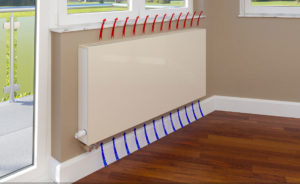
The power of the convector is chosen based on the area of \u200b\u200bthe room it heats. The standard indicator is the power of 1 kW per 10 square meters. m of premises. That is, for a room of 23 square meters. m will require a device with a power of 2.5 kW.
Experts recommend purchasing convectors with a capacity of 10-15% more than the calculated one, equipped with a power adjustment function. This will increase heating at lower outdoor temperatures, as well as more finely tune the heating mode.
Currently, convectors with power from 0.5 to 3 kW are most often used in everyday life.
Electric convector device
in a heat exchange closed chamber
All this is combined in one frame, which has a decorative finish and options for mounting on the floor and on the wall.
The body is equipped with grille windows for supplying warm air into the room, and the body skin is made with air gaps that do not allow getting burned when touching the body.
The front part of the body is used for the location of the buttons for controlling the convector's actions. Electric convectors with a fan are noisy and cannot boast of quiet operation.
Our old dwelling did not meet the power requirements for connecting powerful electrical appliances. It was unprofitable to change the wiring, so we decided to use convector heating in a small house outside the city. We do not permanently live there, and installing a boiler is just an unnecessary waste.
Heating with convectors has led to the fact that we advise all our friends to summer residents to use it in the house. The room always heats up quickly, and we can not say any complaints.
Varieties of convectors by installation method
divided into the following types
Wall-mounted appliances have more power compared to other appliances. They do not take up floor space, so they are easy to use. The disadvantages of this placement option include the fact that warm air does not fall down, but tends to the ceiling, and the floor remains cold.
Floor-standing types of appliances, although they are produced with less power, but because of their location at the very surface of the floor, they heat the room much faster. Convenient is the ability to move to different points, which cannot be done with a permanently fixed wall electric convector.
The device of small-sized electric heating devices in floor niches significantly saves space in small rooms. In recent years, such placement is very popular, although it requires preliminary work.
Positive feedback won skirting types of convectors. which give a feeling of comfort to the feet. Their power is small, but to increase the flow of warm air, some users buy two or more devices, which equates to the energy consumption of a large device.
Different types of thermostats
The temperature controller is adjusted so that in the absence of residents in the house, the heating of the room occurs in a gentle mode and does not require excessive consumption of electrical energy. By time, you can set the mode when the inclusion occurs automatically with the return of the household.
Temperature regulators are mechanical and electronic. The first type significantly reduces the price of the device, but is not very convenient in terms of comfort. He cannot fully track the temperature regime, sometimes he allows, albeit minimal, but additional electricity overruns.
In addition, switching is accompanied by low sounds, which at night can cause trouble to a sleeping person.
Advantages and disadvantages of convector heating
Let's take a look at what the main advantages of convector heating are, and try to present all the advantages in the form of a list:
Installing electric convectors is one of the fastest ways to organize permanent heating of a private house.
- The possibility of heating rooms for any purpose;
- No impact on the air (convector heating does not burn oxygen);
- Weak impact on air humidity;
- Ease of installation of equipment (typical for electrical appliances);
- The absence of a negative impact on well-being (this is what the convector compares favorably with the IR heater);
- Large selection of equipment for the organization of heating.
There are also certain disadvantages:
- Convector heating has little effect on air humidity. However, this is typical for many heating devices;
- Some people don't like the feeling of overheated air;
- Low efficiency in rooms with high ceilings;
- High temperature difference in the lower and upper parts of the rooms.
If we take into account electric convector heating, then it is characterized by another drawback - high cost. But if there is no gas main in the house, and you want the heating system to be inexpensive and easy to install, then you can’t do without convectors
We recommend the installation of electric convector heating in country houses with a small area. In this case, you can get rid of unreasonable costs for laying pipes and installing a heating boiler.
The principle of operation and classification of convectors for home heating
Convector heating of the house can work from different heat sources. It can be:
- Electric heating element. It is used in convectors of the corresponding type.
- metal heat exchangers. They are found in gas convectors for home heating.
- Water convectors. In such heat exchangers, the heat carrier is heated using a central boiler house or a gas boiler.
The air that comes into contact with the heat exchanger is heated and directed upwards. Thus, a directional movement occurs when the warm masses rise to the ceiling, and the cold air flow rushes down to the heat exchanger. You can speed up the convection process by installing vertical fins that direct the air flow.
In heating equipment that runs on natural gas or electricity, special fans and thermostats that create forced convection are subject to additional installation.
Conventionally, all types of convectors can be divided into several categories.
Water convectors
Water convector device
Reviews on heating a house with convectors of this type are mostly positive. Water heating is found in any residential and administrative building where there are convectors. They are a heating device, which consists of a metal pipe and a rib that is fixed on it. According to this design, the movement of the coolant occurs.
Most citizens call this heating central water, but not convector. Although it is the last option that is correct, since the process of convection is observed.
If we talk about water convectors for heating a private house, then they can be built-in floor type. These devices are designed for installation under window openings or in the passage area. Such models can also be used not only in residential buildings, but also in offices and administrative buildings.
Convector heating, operating on the water principle, is effective in systems that have a circulation pump and its heating temperature is at least 80 degrees. In other cases, their work will be ineffective.
Electric type convectors
Electric convectors can be of different modifications and power
These modern models of convectors powered by electricity are quite easy to use and efficient. But for regular heating of a private house with convectors, you should choose more powerful models that have protection against power surges and overheating.
Electric type convectors are mounted on the wall surface and connected to the power supply. The absence of a coolant eliminates its defrosting, thereby allowing the use of heating at any time.As reviews show, it is better to use convector heating at home in the evening, when all residents return home. This results in significant savings in heating costs. In addition, most modern models have timers, with which you can set the required work time throughout the day.
It is necessary to choose the optimal number of devices, taking into account the area of \u200b\u200bthe house itself. On average, for heating 10 sq. m of the room will require a convector with a capacity of 1 kW. Future costs can be calculated knowing the cost of 1 kW and the duration of the heating system.
This is the best option for heating with convectors in a wooden house, cottage and other suburban real estate, since there is no need to use a gas main. In addition, this heating system can be used for irregular work. It is not only reliable and very efficient, but also has a high safety class.
Gas convectors for home heating
The gas type of convector can use a gas line or cylinders for operation. This is a fairly efficient and affordable heating system. One drawback is the need to install a special chimney.
Judging by the reviews, convector heating at home is more efficient and economical than using a gas boiler. Savings lies in the absence of the need to lay a powerful pipe system and install radiator batteries. Such a system is well suited for both permanent and temporary residence.
It should be noted that with the movement of air masses there is a regular movement of dust. This can be uncomfortable for people with allergies or lung disease.
Which brand of electric convector is better to choose
The choice depends on the requirements for the heater, as well as the purchasing power of the person himself.
After evaluating the pros and cons of the equipment offered to the domestic consumer, a small rating of convectors was compiled.
The best option is Noirot Melodie Evolution - a new generation, premium class electric wall-mounted heating convector. Waterproof and wall mountable. With a monolithic heating element, which ensures almost silent operation of the device. Noirot Melodie Evolution is conveniently controlled by a touch panel or LED display (depending on the model). The programmer has several built-in operating modes and the ability to create your own heating schedule. You can purchase a model with a remote control function. With the help of Noirot Melodie Evolution and the GSM notification system, heating a summer house or a country house with electric convectors has become completely safe and comfortable.
The middle class is Electrolux equipment. The company offers the consumer household wall-mounted electric convectors heating with thermostat. Most Electrolux models are universal and can, at the request of the customer, be installed on the floor. It should be borne in mind that this somewhat reduces the performance of the device. A tubular or monolithic heating element is used as a heating element.
Why electric heaters
You will immediately ask yourself why the classic water or stove heating of rooms is not considered? The answer is simple - this is due to the fact that installation work and maintenance for about the same money will be minimized.
Now we will provide several reasons why it is obvious that the best and most economical heating system for a private house is electric.
- Heaters powered by electricity are silent, do not require additional resources (coal, firewood, liquid fuel) and, moreover, do not pollute the atmosphere. This suggests that in a private house it is not necessary to have a place in the utility block for fuel, to make a chimney and, moreover, to soot every year.It is enough to connect the system to the network and enjoy the heat.
- Installing an entire electric heating system does not require a huge initial investment. For example, the installation of a water heating main is carried out once. A project is being created, all pipes, radiators, a boiler, as well as additional automation are purchased. To do part of the work (for example, in one room), and if you have money, you will not be able to complete the project over time, and if you do, then many problems will arise. It will be necessary to drain the water, crash into the finished highway, etc. In the case of electric heaters, everything is much simpler. You can install equipment in each room separately as you earn money. At the end of spring, buy convectors for the bedroom, later - for the kitchen, bathroom, etc.
- Today, there are many ways to save on energy consumption. Of course, this option requires considerable costs, but be sure that over time they will pay for themselves. The installation of economical two-tariff meters, as well as solar panels on the roof of the house, is popular.
- Connecting a boiler, boiler or even a convector can be done by hand, significantly saving money on calling the master.
As you can see, electric heating in a private house really outperforms alternative options, so installing such a system is quite profitable.
Homemade Economic Battery Electric Heating System
Convector how it works
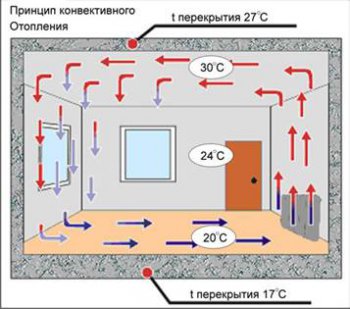
- Electrical heating elements. In this case, we are talking about electric convectors.
- Heat exchangers through which a heat carrier moves, which can be heated by a heating boiler or a district boiler house (central heating). Accordingly, heating devices are called water convectors.
- Metal heat exchangers, which are heated by burning gas. In this case we are talking about gas convectors
The air, in contact with the heat exchanger, heats up and rises. This creates a directed movement of air masses, forcing colder air masses to move faster towards the heat exchanger, and then rise up. To improve convection, vertical fins are installed on the heat exchanger, which form the direction of air flow.
In electric and gas convectors, thermostats and fans are additionally installed to create forced (more intense) convection. In water convectors, fans are provided for models built into the floor or window sill.
The convector can be equipped with one of the following types of heating element
- Needle - is a thin plate with a nickel thread. This design is very fragile and can quickly fail, so it is not popular with specialists.
- Tubular - has a reliable design and not too high cost. But keep in mind that such a convector at the initial stage of operation after switching on can click until the tubes heat up.
- A monolithic element is the most reliable and expensive, but it will last a long time.
For the needs of stationary heating in a country house, convectors with monolithic heaters will be the best option. If the budget is not designed for such expenses, then choose a convector with a tubular heater.
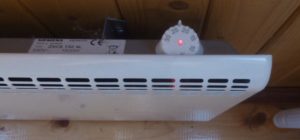
Calculation of the power of such a heating device
Table for calculating the power of such a heating device.
To select the average power of devices for heating residential and office premises, you should use the formula: 1 kW of heat per 10-12 m² of the area of \u200b\u200bthe room (if the height of the walls is 2.7 m). If there is a high wall height, it is recommended to add 10% power for every 10 cm above the specified one. Each window opening must be covered with heat flow. A convector should be installed under it, while it is recommended to choose a design of the same length as the width of the window. For practical use, the most optimal is a device that is capable of completely covering the window opening in length. A wide heat flow at an optimal speed will act as a curtain and effectively maintain a uniform temperature balance in the room.
In order to more accurately determine the power of the convector, which is necessary for heating the room, the calculation should be made according to the volume of the room, based on the calculation of 35-40 W / m³. It will also be necessary to take into account the additional heat losses that exist in connection with the outer walls. If there is a corner room with a cold attic, basement, or if it has a large glass area, it is recommended to select equipment with some power reserve. This will greatly affect the rate of heating the space to the required temperature. If you take a model that has low power, it may happen that the device simply cannot reach the required temperature and will work continuously.
Modern convectors in most cases consume only 30-40% of their total rated power.
In general, each model of the convector has its advantages and disadvantages. However, the advantages include the following characteristics:
- You should choose those devices that do not burn oxygen.
- You need to give preference to designs that can be used in absolutely any room.
- It is best to choose batteries that are easy to install and operate.
- Batteries that have the highest level of safety are valued more than others.
It is worth noting that each owner of an apartment or house chooses the best convector for himself.
The choice must be made based on your own capabilities and needs, as well as the place where you plan to install it.
Which company is best to choose such a device for heating?
Diagram of the Bessemer converter.
In order to understand which company produces the best convectors, you need to listen to customer reviews. For example, Delonghi most often produces cheap convector equipment that runs on electricity.
In general, people's reviews about this manufacturer are quite good, especially if you take into account their democratic cost.
The well-known organization Gorenje produces various types of convectors. However, consumers are most in demand for a gas-type heating device of this well-known brand. Reviews about the products they produce are in most cases good, but their units have a considerable cost, which must be taken into account when choosing a heating device for an apartment or a country house.
There are also convector manufacturers who have a fairly large number of bad reviews. Such manufacturers include Ballu, Selena, Timberk and others. All company data is Chinese.
What should you know about the cost of electric convectors? In general, such devices for heating an apartment or house are quite convenient and have a large number of advantages in comparison with other heating units. For many consumers, the main advantage is the cost of these designs, because they believe that even the best devices can be cheap. To some extent, people who want to save money are right. Not always expensive equipment will justify its price.
Often there are situations when a low cost hides a large number of positive aspects. You should be aware that the price is not the main criterion for choosing such heating equipment.
